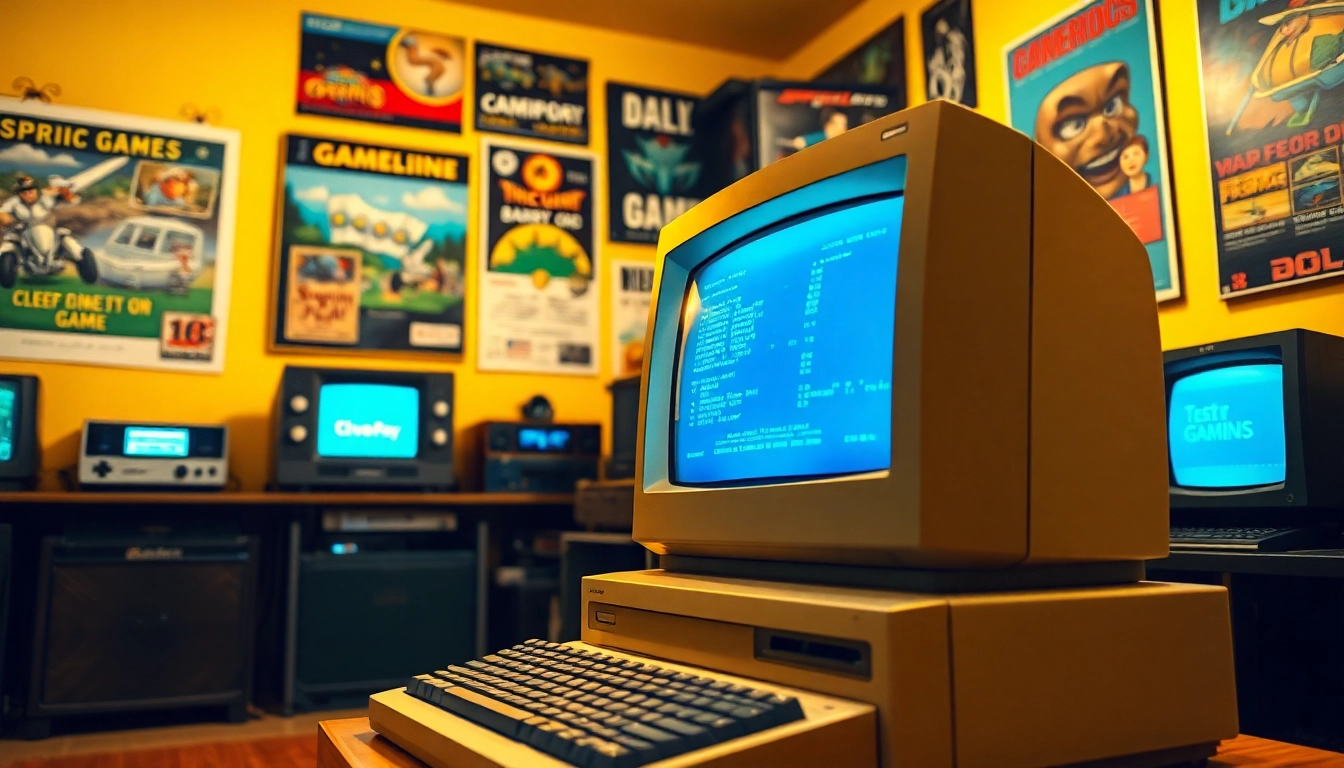Introduction to DOS Games
In the world of gaming, few experiences can evoke the same level of nostalgia as playing DOS games. For many, these titles represent the very foundation of computer gaming, with their pixelated graphics and chiptune music offering a stark contrast to today’s hyper-realistic graphics and expansive open worlds. Diving into the realm of DOS games can be both a thrilling adventure and a profound historical journey through the annals of technology. Whether you are venturing back to your childhood or exploring this interesting segment of gaming for the first time, there is a wealth of content and experiences waiting for you. So, let’s explore how you can play dos games in a way that enhances your enjoyment while understanding their rich history and cultural significance.
Understanding DOS Gaming History
The history of DOS gaming dates back to the early 1980s, coinciding with the rise of personal computers. DOS, or Disk Operating System, served as the backbone for early gaming before the advent of graphical user interfaces. Pioneers like IBM adopted DOS for their personal computers, which unlocked the doors for game developers to create software that would forever change how we entertain ourselves.
Early titles such as “Castle Wolfenstein,” “Commander Keen,” and “Doom” pushed the boundaries of technology at the time and set the standard for future games. These early experiences were instrumental in shaping the gaming landscape, influencing design elements and gameplay mechanics that are still present in modern gaming. As such, understanding the origins of DOS games enriches our appreciation for them and helps us comprehend the evolutionary path of the gaming industry.
The Appeal of Playing DOS Games
Why do so many players gravitate towards DOS games? The appeal lies in a combination of nostalgia, simplicity, and the thrill of discovering classic gameplay mechanics that modern games may overlook. For many who grew up in the 80s and 90s, these titles represent a portal to their formative years filled with countless hours of gameplay and adventure.
Moreover, playing DOS games is not restricted to personal nostalgia; it also serves as a cultural touchstone for younger generations discovering these titles for the first time. The simplistic graphics and straightforward mechanics invite players to focus on core gameplay elements, sparking imagination in ways that can sometimes be lost in modern, visually intensive experiences.
Different Types of DOS Games Available
The DOS gaming library is vast, encompassing a multitude of genres that appeal to various player preferences. Here are some prominent types:
- Platformers: Games like “Commander Keen” and “Prince of Persia” highlight agility and timing, offering memorable experiences that are both challenging and rewarding.
- Adventure Games: Titles such as “King’s Quest” and “Space Quest” invite players into richly woven narratives filled with puzzles and exploration.
- RPGs: Role-playing games like “Bard’s Tale” brought players into expansive worlds with character development and storytelling at their core.
- Action and Shooter Games: The likes of “Doom” and “Duke Nukem” set benchmarks in the first-person shooter genre, delivering frantic action and immersive environments.
Each genre harbors a unique kind of gameplay and storytelling, allowing players to engage with DOS games on multiple levels and find experiences tailored to their tastes.
How to Play DOS Games on Your Computer
The revival of interest in retro gaming has made it easier than ever to enjoy DOS games, even on modern systems. Here’s how you can get started.
Setting Up a DOS Emulator
The first step in playing DOS games on contemporary computers is to set up a DOS emulator. DOSBox is the most renowned option due to its user-friendly interface and high compatibility with a spectrum of DOS games. Here’s how to set it up:
- Download DOSBox from its official website.
- Install DOSBox by following the on-screen instructions.
- Create a folder on your computer to house your DOS games (e.g., C:\DOSGames).
- Launch DOSBox and mount the folder by typing
mount c C:\DOSGames. - Change to the virtual drive by typing
c:.
After these steps, you can run DOS games by simply typing their executable file name (e.g., game.exe). This process opens up a world of retro games at your fingertips.
Finding and Downloading DOS Games
Once your DOS emulator is set up, it’s time to find and download games. Numerous websites offer archives of classic DOS titles, making acquiring your favorites straightforward. Popular resources include:
- Abandonware sites that host old games that are no longer sold.
- Classic game repositories that provide both freeware and shareware titles.
- Fan-made versions and remakes that can also be played on modern systems.
When downloading games, ensure that they are compatible with your emulator and free from any malicious software.
Running DOS Games on Modern Operating Systems
Most DOS games were designed for a vastly different hardware ecosystem than today’s systems. When running these games, players may encounter challenges related to operating system compatibility.
To successfully run DOS games on modern operating systems, utilize DOSBox, which emulates the DOS environment required for these titles. Configure your DOSBox settings to customize performance, such as adjusting CPU cycles or graphics settings, to enhance your gaming experience.
Furthermore, if you prefer not to use emulators, some DOS games have been ported to modern platforms or available within comprehensive packages that include various DOS titles with enhanced compatibility layers. Consider the best option that suits your gaming preferences.
Enhancing Your DOS Gaming Experience
Getting the most out of your DOS gaming experience goes beyond just playing the games. Here are some effective ways to enhance your fun.
Optimizing Graphics and Sound Settings
While classic DOS games may have rudimentary graphics, optimizing settings can make a significant difference in performance. Inside DOSBox, tweak the graphics settings such as the output mode to suit your monitor and enjoy smoother visuals. Using filters or enhancing resolution in certain emulators can also produce a more pleasant visual experience.
As for sound, configure your DOSBox sound options to match your game’s requirements. Many DOS titles use Sound Blaster for audio, so ensuring proper emulation of sound hardware is crucial for a full experience.
Creating a Nostalgic Atmosphere with Accessories
Recreating the nostalgic feel of the DOS gaming era can significantly enhance enjoyment. Consider utilizing accessories like:
- Mechanical Keyboards: The tactile feedback can replicate the feel of typing on old systems.
- Retro Controllers: Many retro USB controllers are available, allowing for a more authentic gaming experience.
- Ambient Lighting: Setting up your gaming space with nostalgic colors can evoke memories and set the mood for play.
These accessories can transport players back in time, heightening emotional connection and enjoyment.
Using Cheats and Mods for Enhanced Gameplay
Cheats and modifications can drastically change how a DOS game is played, introducing new challenges or easing difficulties. For many classic titles, cheat codes and tweaks enhance replayability and player engagement. Players can find guides for cheat codes online or join community forums where they share their modifications and experiences.
Modifying games can also bring exciting enhancements, such as improved graphics, expanded storylines, or new characters, offering a renewed sense of exploration even in well-known titles.
Challenges When Playing DOS Games
As exhilarating as immersing yourself in DOS games can be, there are notable challenges to consider. Here are common obstacles players face and their potential solutions.
Common Technical Issues and Fixes
Technical issues while gaming can be frustrating. Common problems include:
- Audio Glitches: These can often be resolved by adjusting sound settings in DOSBox or using different audio drivers.
- Screen Resolution Problems: Players can address resolution issues by configuring DOSBox settings or using a graphical frontend to manage game settings more intuitively.
- Saving Game Issues: Ensure that the directories where you are saving these files are writable and correctly mounted in DOSBox.
Troubleshooting these problems is often manageable with careful configuration and community support.
Compatibility Problems with Modern Hardware
Modern hardware often creates compatibility concerns for older DOS games. Players may experience difficulties related to graphics cards, new CPUs, or operating system limitations.
Utilizing emulators or specially designed versions of games that have been modified for modern systems can often mitigate these issues. Keeping your software up-to-date and researching specific solutions for the games that you enjoy can also help overcome compatibility barriers.
Addressing Performance and Lag Issues
Performance problems, including lag and slow gameplay, can detract from the experience. Adjusting the CPU cycles within DOSBox can provide smoother gameplay. Increasing or decreasing this measurement until the game runs efficiently is often the key to improving performance.
The emulator also allows customizing the graphics output, enhancing visual performance accordingly. Regular updates to your emulator software may introduce optimizations that positively affect how games run on your system.
Engaging with the DOS Gaming Community
Connecting with fellow enthusiasts can significantly enhance your experience. The DOS gaming community is vibrant, full of shared resources, discussions, and events.
Joining Online Forums and Communities
Participating in online forums dedicated to DOS gaming can provide you with countless tips, tricks, and insights from seasoned gamers. Platforms like Reddit, Discord, and dedicated gaming sites feature channels where players share their experiences, seek help, and exchange recommendations on titles and emulators.
By engaging in these communities, you can broaden your knowledge of gameplay mechanics, historical contexts, and tricks that can enhance your enjoyment further.
Sharing Tips and Tricks
Sharing what you’ve learned with others can be very rewarding. As you continue to explore DOS games, consider documenting your experiences and strategies in blog posts or contributing to forum discussions. This interaction contributes to the growing knowledge base associated with retro gaming and helps you forge connections with others who share your interests.
Participating in Retro Gaming Events
Every year, countless gaming conventions and meetups allow fans of retro gaming to connect in person. Taking part in events such as game fairs, local meetups, or tournaments can provide unique opportunities to experience DOS games in a social context.
These gatherings often showcase classic titles, offer competitions, and create a space for sharing tips, experiences, and love for retro gaming. Through these events, you may discover new friends who share your passion for the classic gaming experience.
In conclusion, the allure of DOS games continues to captivate new and nostalgic players alike. By understanding their historical context, setting up the necessary technology, and becoming engaged in the community, any gamer can immerse themselves in this cherished era of video gaming. Whether you are a die-hard fan or a newcomer intrigued by vintage gaming, the world of DOS games offers endless adventures waiting to be explored.



